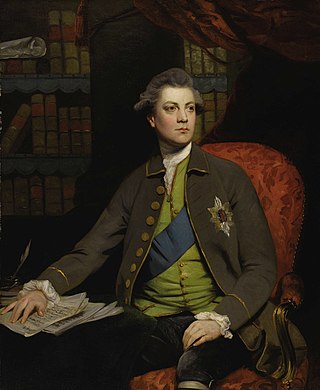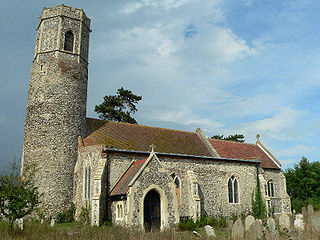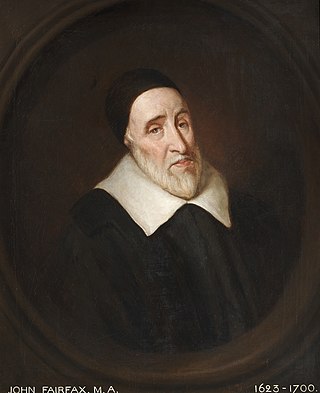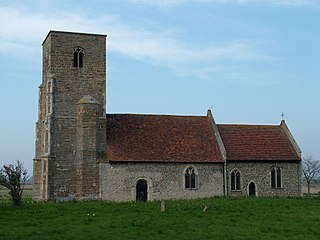
Woodbridge is a port town and civil parish in the East Suffolk district of Suffolk, England. It is 8 miles (13 km) up the River Deben from the sea. It lies 7 miles (11 km) north-east of Ipswich and around 74 miles north-east of London.

Simon Sudbury was Bishop of London from 1361 to 1375, Archbishop of Canterbury from 1375 until his death, and in the last year of his life Lord Chancellor of England. He met a violent death during the Peasants' Revolt in 1381.

Thomas Fairfax, 3rd Lord Fairfax of Cameron, also known as Sir Thomas Fairfax, was an English politician, general and Parliamentary commander-in-chief during the English Civil War. An adept and talented commander, Fairfax led Parliament to many victories, notably the crucial Battle of Naseby, becoming effectively military ruler of England, but was eventually overshadowed by his subordinate Oliver Cromwell, who was more politically adept and radical in action against Charles I. Fairfax became unhappy with Cromwell's policy and publicly refused to take part in Charles's show trial. Eventually he resigned, leaving Cromwell to control the country. Because of this, and also his honourable battlefield conduct and his active role in the Restoration of the monarchy after Cromwell's death, he was exempted from the retribution exacted on many other leaders of the revolution.

Henry Howard, 12th Earl of Suffolk, 5th Earl of Berkshire, KG, PC, was a British politician, styled Viscount Andover from 1756 to 1757.

Henry Grey, Duke of Suffolk, 3rd Marquess of Dorset, was an English courtier and nobleman of the Tudor period. He was the father of Lady Jane Grey, known as "the Nine Days' Queen".

Humphrey Prideaux was a Cornish churchman and orientalist, Dean of Norwich from 1702. His sympathies inclined to Low Churchism in religion and to Whiggism in politics.

Sproughton is a village in Suffolk, England, just to the west of Ipswich and is in the Babergh administrative district. It has a church, a primary school, a pub, a community shop and various groups. It is in the Belstead Brook electoral division of Suffolk County Council.

Aldham is a village and civil parish in the Babergh district of Suffolk, England. Located around 8 miles (13 km) west of Ipswich, in 2005 it had a population of 200, reducing to 175 at the 2011 Census.

Blundeston is a village and civil parish in the north of the English county of Suffolk. It is 3.5 miles (5.6 km) north-west of Lowestoft, 6 miles (9.7 km) south of Great Yarmouth and around 1.75 miles (2.82 km) inland from the North Sea coast. It is part of the area known as Lothingland in the East Suffolk district. Blundeston Prison was located on the southern edge of the village but closed in early 2014.

Mutford is a village and civil parish in the East Suffolk District of the English county of Suffolk. The village is 5 miles (8.0 km) south-west of Lowestoft and 4 miles (6.4 km) south-east of Beccles in a rural area. The parish borders Barnby, Carlton Colville, Gisleham, Rushmere, Henstead with Hulver Street, Ellough and North Cove. The village gave its name to the Half Hundred of Mutford which is named in the Domesday Book.

John Gilbert was Archbishop of York from 1757 to 1761.
David Wilkins (1685–1745), originally named Wilke or Wilkius, was a Prussian orientalist, born in Memel, who settled in England. His 1716 publication of the Coptic New Testament was the editio princeps.

The siege of Colchester occurred in the summer of 1648 when the Second English Civil War reignited in several areas of Britain. Colchester found itself in the thick of the unrest when a Royalist army on its way through East Anglia to raise support for the King, was attacked by Lord-General Thomas Fairfax at the head of a Parliamentary force. The Parliamentarians' initial attack forced the Royalist army to retreat behind the town's walls, but they were unable to bring about victory, so they settled down to a siege. Despite the horrors of the siege, the Royalists resisted for eleven weeks and only surrendered following the defeat of the Royalist army in the North of England at the Battle of Preston (1648).

For the church building designed by Frank Lloyd Wright see Unitarian Meeting House
Lewis Nockalls Cottingham was a British architect who pioneered the study of Medieval Gothic architecture. He was a restorer and conservator of existing buildings. He set up a Museum of Medieval Art in Waterloo Road, London with a collection of artefacts from demolished buildings and plaster casts of the medieval sculpture.
The Archdeacon of Suffolk is a senior cleric in the Diocese of St Edmundsbury and Ipswich.
Sir Thomas Fairfax was an owner of Gilling Castle, near Gilling East, North Riding of Yorkshire, England.

John Fairfax (1623–1700) was an English ejected minister.

Wantisden is a small village and civil parish in the East Suffolk district of Suffolk in eastern England. Largely consisting of a single farm and ancient woodland, most of its 30 residents live on the farm estate. It shares a parish council with nearby Butley and Capel St. Andrew. It has a church dedicated to St John the Baptist.
Matthias Candler, also known as Matthias Gillet, was an English Church of England clergyman, topographer and antiquarian. He compiled an extensive survey of Suffolk and its families in the 1650s.














